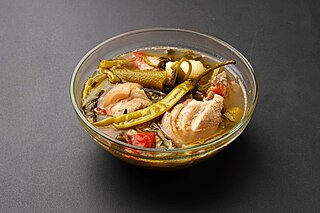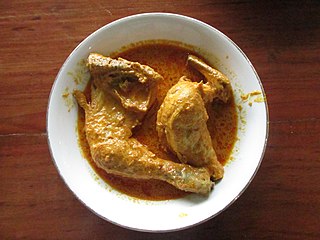Related Research Articles

Indonesian cuisine is a collection of various regional culinary traditions that formed in the archipelagic nation of Indonesia. There are a wide variety of recipes and cuisines in part because Indonesia is composed of approximately 6,000 populated islands of the total 17,508 in the world's largest archipelago, with more than 1,300 ethnic groups.

Laksa is a spicy noodle dish popular in Southeast Asia. Laksa consists of various types of noodles, most commonly thick rice noodles, with toppings such as chicken, prawns or fish. Most variations of laksa are prepared with a rich and spicy coconut curry soup or a broth seasoned with asam.

Malay cuisine is the traditional food of the ethnic Malays of Southeast Asia, residing in modern-day Malaysia, Indonesia, Singapore, Brunei, Southern Thailand and the Philippines as well as Cocos Islands, Christmas Island, Sri Lanka and South Africa.

Tempoyak, asam durian or pekasam is a Malay condiment made from fermented durian. It is usually consumed by the ethnic Malays in Maritime Southeast Asia, notably in Indonesia and Malaysia. Tempoyak is made by taking the flesh of durian and mixing it with some salt and kept in room temperature for three or five days for fermentation. Tempoyaks are usually made during the durian season, when the abundance of durian and excess production are made into fermented tempoyak.

Sinigang is a Filipino soup or stew characterized by its sour and savory taste. It is most often associated with tamarind, although it can use other sour fruits and leaves as the souring agent such as unripe mangoes or rice vinegar. It is one of the more popular dishes in Filipino cuisine. This soup, like most Filipino dishes, is usually accompanied by rice.

Lontong is an Indonesian dish made of compressed rice cake in the form of a cylinder wrapped inside a banana leaf, commonly found in Indonesia, Malaysia, and Singapore. Rice is rolled inside a banana leaf and boiled, then cut into small cakes as a staple food replacement for steamed rice. The texture is similar to that of ketupat, with the difference being that the ketupat container is made from woven janur fronds, while lontong uses banana leaf instead.

Javanese cuisine is the cuisine of Javanese people, a major ethnic group in Indonesia, more precisely the province of Central Java, Yogyakarta and East Java.

Pepes is an Indonesian cooking method using banana leaves as food wrappings. The banana-leaf package containing food is secured with lidi seumat and then steamed or grilled on charcoal. This cooking technique allows the rich spice mixture to be compressed against the main ingredients inside the individual banana-leaf package while being cooked and also adds a distinct aroma of cooked or burned banana leaves. Although being cooked simultaneously with food, the banana leaf is a non-edible material and is discarded after consuming the food.

Botok or ꦧꦺꦴꦛꦺꦴꦏ꧀(Bothok) is a traditional Javanese dish made from grated coconut flesh which has been squeezed of its coconut milk, often mixed with other ingredients such as vegetables or fish, and wrapped in banana leaf and steamed. It is commonly found in the Javanese people area of Java Island (Yogyakarta Special Region, Central, and East Java. It has a soft texture like the mozzarella cheese and is usually colored white.
Nasi bogana or nasi begana, pronounced as nah-see boh-gâna, is an Indonesian-style rice dish, originally from Tegal, Central Java. It is usually wrapped in banana leaves and served with side dishes.

Telur pindang or pindang eggs are hard-boiled eggs cooked in the pindang process, originating from Javanese cuisine, Indonesia, and popular in Malay as well as Palembang cuisine. The eggs are boiled slowly in water mixed with salt, soy sauce, shallot skins, teak leaf, and other spices. Due to its origins, it bears striking similarities with Chinese tea eggs. However, instead of black tea, this version uses leftover shallot skins, teak leaves or guava leaves as dark brownish coloring agents.

Asam pedas is a Maritime Southeast Asian sour and spicy fish stew dish. Asam pedas is believed to come from Minangkabau cuisine of West Sumatra, Indonesia and has spread throughout to the islands of Sumatra, Borneo and the Malay Peninsula.

Sambal is an Indonesian chili sauce or paste, typically made from a mixture of a variety of chilli peppers with secondary ingredients such as shrimp paste, garlic, ginger, shallot, scallion, palm sugar, and lime juice. Sambal is an Indonesian loanword of Javanese origin. It originated from the culinary traditions of Indonesia and is also an integral part of the cuisines of Singapore, Malaysia, Brunei, and Sri Lanka. It has also spread through overseas Indonesian populations to the Netherlands and Suriname.

Gulai is a class of spicy and rich stew commonly found in Malay Archipelago. The main ingredients of the dish are usually poultry, goat meat, beef, mutton, various kinds of offal, fish, and seafood, as well as vegetables such as cassava leaves, unripe jackfruit, and banana stem.

Rujak or rojak is a salad dish of Javanese origin, commonly found in Indonesia, Malaysia and Singapore. The most popular variant in all three countries is a salad composed of a mixture of sliced fruit and vegetables served with a spicy palm sugar dressing. It is often described as tangy and spicy fruit salad due to its sweet, hot and spicy dressing made from ground chilli, palm sugar and peanuts.

Pindang refers to a cooking method in the Indonesian and Malay language of boiling ingredients in brine or acidic solutions. Usually employed to cook fish or egg, the technique is native to Sumatra especially in Palembang, but has spread to Java and Kalimantan. The term also could refer to a specific sour and spicy fish soup which employs seasonings like tamarind. Pindang has food preservation properties, which extends the shelf life of fish products.

Palembangese cuisine is the cuisine of the Palembangese people of the city of Palembang in the South Sumatra province of Indonesia. It is the second most well-known cuisine from Sumatra after Padang.

Pekasam, Pakasam or Bekasam is a Malay term for fermented food, more precisely fermented fish product. In Malay and Banjar cookery, pekasam usually refers to freshwater fish fermented with salt, palm sugar, toasted rice grains and pieces of asam gelugur.
References
- 1 2 "Kumpulan Resep Asli Indonesia | Brengkes Ikan Asin Peda". lestariweb.com. Retrieved 2021-01-12.
- ↑ "Pengrajin Pindang Rowosari Tak Terpengaruh Pandemi". Halo Semarang (in Indonesian). Retrieved 2021-01-12.
- ↑ Nukti, Yuniari (2016-11-05). "Brengkesan Pindang Cue yang segar, lezat, dan sehatnya menggoda". Yuniari Nukti. Retrieved 2021-01-12.
- ↑ Indonesia, Hello (2019-12-05). "Brengkes Tempoyak, Fish and Durian Blend into one dish". Hello Indonesia. Retrieved 2021-01-12.
- ↑ "New Menus from Dapur Babah". Tugu Hotels & Restaurants. 2015-03-05. Retrieved 2021-01-12.